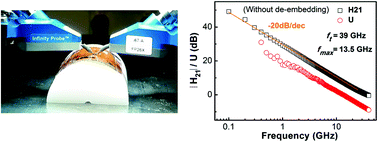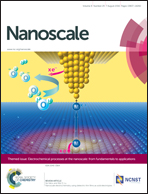Mechanically robust 39 GHz cut-off frequency graphene field effect transistors on flexible substrates†
Abstract
Graphene has been regarded as a promising candidate channel material for flexible devices operating at radio-frequency (RF). In this work we fabricated and fully characterized double bottom-gate graphene field effect transistors on flexible polymer substrates for high frequency applications. We report a record high as-measured current gain cut-off frequency (ft) of 39 GHz. The corresponding maximum oscillation frequency (fmax) is 13.5 GHz. These state of the art high frequency performances are stable against bending, with a typical variation of around 10%, for a bending radius of up to 12 mm. To demonstrate the reliability of our devices, we performed a fatigue stress test for RF-GFETs which were dynamically bend tested 1000 times at 1 Hz. The devices are mechanically robust, and performances are stable with typical variations of 15%. Finally we investigate thermal dissipation, which is a critical parameter for flexible electronics. We show that at the optimum polarization the normalized power dissipated by the GFETs is about 0.35 mW μm−2 and that the substrate temperature is around 200 degree centigrade. At a higher power, irreversible degradations of the performances are observed. Our study on state of the art flexible GFETs demonstrates mechanical robustness and stability upon heating, two important elements to assess the potential of GFETs for flexible electronics.


 Please wait while we load your content...
Please wait while we load your content...